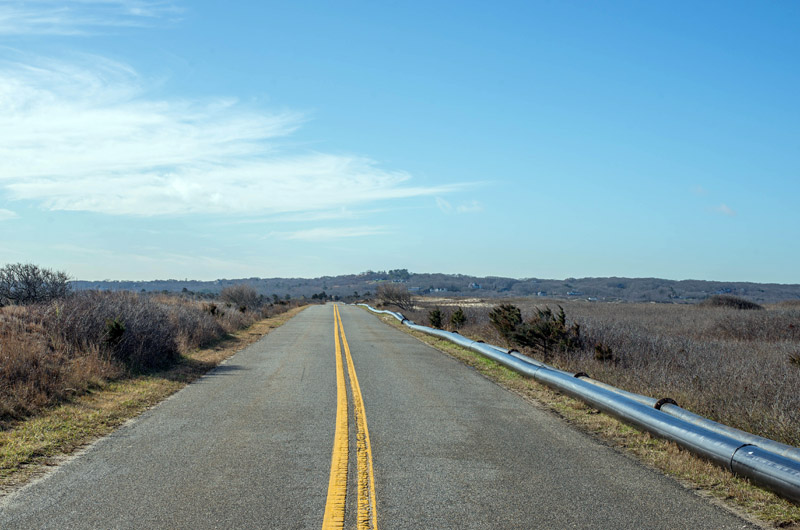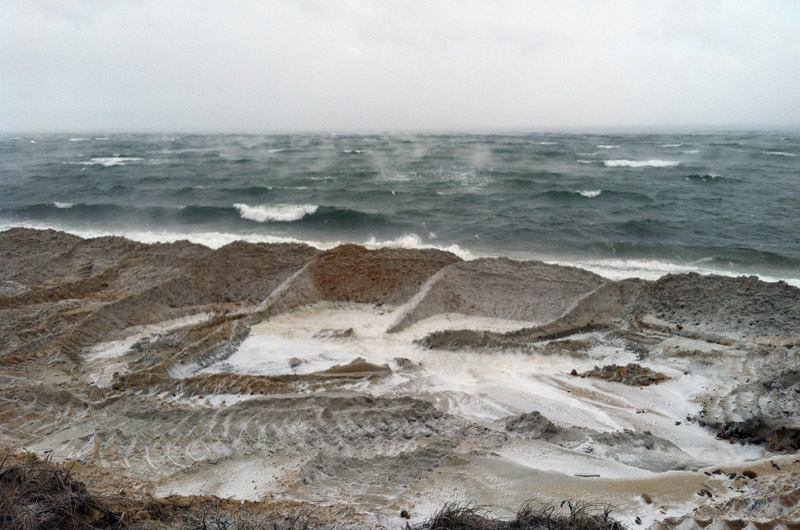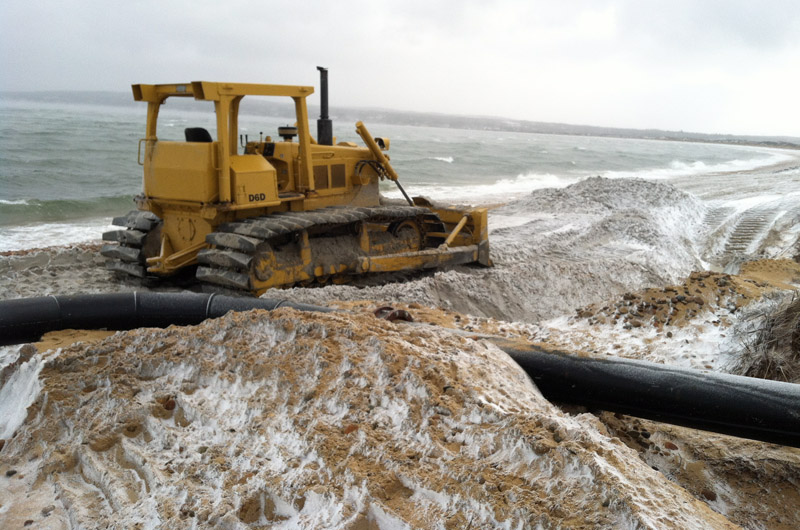A major project to dredge Menemsha Channel is underway, with a barge stationed on Menemsha Pond and more than a mile of piping laid along the shore between the pond and Lobsterville Beach.
On Tuesday morning, a thin layer of sea smoke hung over the pond, where the dredge was visible in the distance. The pipeline extended along the Aquinnah side of the pond, connecting to a large hydraulic pump at the West Basin parking lot.
The pipeline continued about 1.5 miles down the road in Aquinnah, ending at Lobsterville Beach, which was severely damaged during Hurricane Sandy in 2012.
A single worker took shelter in a wooden shed beside the road, next to a diesel generator and a bulldozer that was idling on the beach. A few seagulls navigated the snow and wind as waves crashed nearby. The dredge was temporarily stopped as workers performed maintenance, and a clump of ice hung down from the end of the pipe.
After the beach is restored, the Wampanoag Tribe of Gay Head (Aquinnah) plans to reinforce it with beach grass and shrubbery in the spring.
The dredging was expected to begin in October, but heavy storms including Hurricane Joaquin in October delayed the movement of the dredge north from Georgia.
Everything else, including the PVC piping and a large blue and yellow pump that resembles a steam engine, has been in place for several weeks. J-Way Southern Inc., of Avon, Ohio, is the subcontractor for the project.
The dredge arrived just before Christmas, and took up its place on the pond. On Tuesday it was stationed on a barge at the north end of the pond, working its way out toward the jetties, which the Army Corps rebuilt last year.
The jetties and a portion of Menemsha Basin have been federal projects since the 1930s, and the area including Menemsha Pond is considered a harbor of refuge for ships. The entire channel was last dredged in 1973.
In response to the current project, Chilmark and Aquinnah, which share the channel and the pond, are working to designate anchorages on both sides of the town line, and to establish new regulations to handle an expected surge in boat traffic.
On Tuesday, the pond was mostly empty except for the barge and its two stabilizer spuds that rose like smoke stacks in the distance. In the harbor was another barge that had been used to drive the spuds.
Much of the dredging occurs out of sight. Below the surface, a large drill bit, known as a cutterhead, chews up the channel floor, while a hydraulic pump on the barge sucks the sand into the pipe. Booster pumps along the route keep the sand and water moving toward the beach.
“We are actually moving mostly water,” Army Corps project manager Craig Martin said. “Even super-efficient hydraulic dredging is only anywhere from 15 to 18 per cent sediment.” As portions of the beach fill up, the pipeline is moved farther east — a process that will continue until the beach is restored.
Most of the sand in the channel started out at Lobsterville but was carried east by the currents. “It’s similar, almost exactly similar, to where we are placing it on the beach,” Mr. Martin said of the sand. He added that the dredge has not yet been caught up in lobster pots or other fishing gear, which could slow progress.
J-Way Southern Inc. has until Jan. 31 to complete the project before the arrival of winter flounder, which spawn in inshore waters. An extension is possible, Mr. Martin said, but would require the approval of state and federal resource agencies.
The Army Corps was slotted for $5.08 billion in federal emergency relief funds after Hurricane Sandy, and is now working on a number of similar dredging projects in New England. Mr. Martin said the $2.17 million project in Menemsha was still on budget.
He was optimistic that the project would be finished on time, but cautioned that some factors can’t be controlled. “If we had some really bad storms like we did last year — it’s hard to account for that,” he said. “But as of today we are set to complete.”









Comments (1)
Comments
Comment policy »